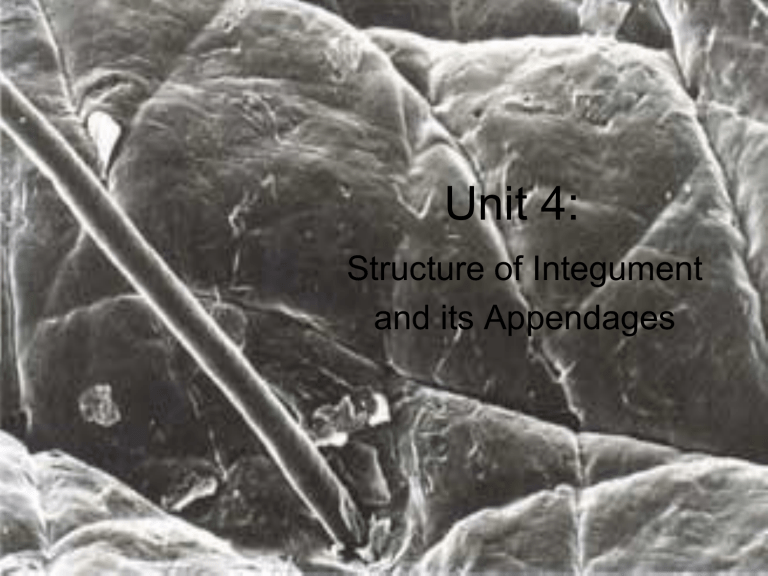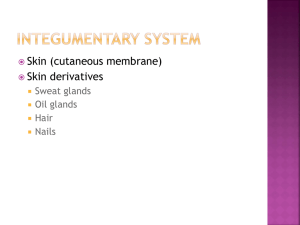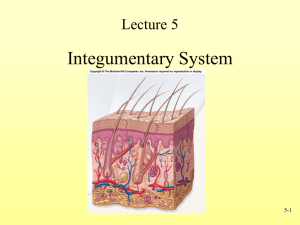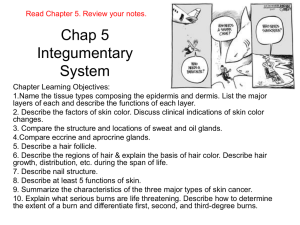ppt

Unit 4:
Structure of Integument and its Appendages
Regions of Integument (skin) Epidermis – outermost region
• Keratinized stratified squamous epithelium
•Non-vascular
•4 cell types
•4 - 5 layers
4 Epidermal Cell Types
Keratinocytes – make keratin fibrous protein
•Protective
•Hardens and waterproofs skin.
•Cells connected by desmosomes:
•prevent tearing and cell separation from mechanical stress
•Arise from hightly mitotic stratum basale
•Cells dead at free surface
4 Epidermal Cell Types
Keratinocytes – make keratin fibrous protein
Langerhans’ Cells – star shaped, epidermal dendritic phagocytic cells
•activate the immune system
•ingest foreign material
4 Epidermal Cell Types
Keratinocytes – make keratin fibrous protein
Langerhans’ Cells – star shaped, epidermal dendritic phagocytic cells
Merkyl Cells – half-sun touch receptors
•associated w/ sensory nerve endings
melanin
4 Epidermal Cell Types
Keratinocytes – make keratin fibrous protein
Langerhans’ Cells – star shaped, epidermal dendritic phagocytic cells
Merkel Cells – half-sun touch receptors
•associated w/ sensory nerve endings
Melanocytes – makes brown pigment melanin
•shields keratinocyte DNA from UV damage
Layers of the Epidermis
Stratum corneum
Stratum lucidum
(absent in thin skin)
Stratum granulosum
Stratum
Spinosum
Stratum basale
Stratum Basale (Basal Layer)
• AKA stratum germinativum
• Deepest epidermal layer, attached to the dermis
• Single row of the youngest keratinocytes
• Rapidly mitotic, making new cells daily
• Melanocytes and Merkyl cells found here
Stratum basale dermis
Stratum Spinosum (Prickly Layer)
• Cells filled with filaments connected to desmosomes. (gives prickly look)
• Melanin granules filling cells in response to UV
Stratum or genetics
Spinosum
Stratum basale
• Langerhans’ cells found here dermis
Stratum Granulosum (Granular)
Stratum granulosum
Stratum
Spinosum
• 3-5 cell layers
• Keratinocytes change, flatten, lose nuclei
• Keratin granules accumulate in the cells of this layer
• Lamellated granules release extracellular glycolipids in intercellular space that waterproof skin
Stratum basale
• Too far from nutrient rich dermal blood, cells begin to die dermis
Stratum Lucidum (Clear Layer)
Stratum lucidum would be here, if present
Stratum granulosum
Stratum
Spinosum
Stratum basale
• Transparent band of flat, dead keratinocytes
• Only in thick skin
– Sole of feet, palms, calluses
• Reduces friction between the granulosum (inferior) and the corneum
(superior) dermis
Stratum Corneum (Horny Layer)
dermis
Stratum corneum
Stratum lucidum would be here, if present
Stratum granulosum
Stratum
Spinosum
Stratum basale
• 20-30 layers of DEAD keratinized cells; ¾ of epidermal thickness
• Functions include:
– Waterproofing (due to glycolipids)
– Protection from:
• Abrasion
• Penetration
• biological, chemical, and physical assaults
Stratum Corneum (Horny Layer)
Stratum C orneum
Stratum L ucidum
Stratum G ranulosum
C an
L ittle
G irls
Stratum S pinosum
Stratum B asale
S mell
B ad ?
dermis
Regions of Integument (skin) Epidermis – outermost region
• Keratinized stratified squamous epithelium
•Non-vascular
•4 cell types
•4 - 5 layers
Dermis – middle region
• Vascularized
• 80% dense irregular connective tissue
• 20% areolar connective tissue
Overview of the Dermis
• Cell types: fibroblasts, phagocytes, mast cells and white blood cells
• Composed of two layers – papillary (upper) and reticular (lower)
• Rich with nerves, blood and lymph vessels
• Most hair follicles, oil and sweat glands derived here
Papillary Layer of Dermis
projections
(reason for endings (pain)
Reticular Layer of the Dermis
• 80% of the thickness of the dermis (dense
–irregular CT)
• Collagen fibers:
– add strength and resiliency
– Binds water, keeping skin hydrated
• Elastin fibers:
– stretch-recoil properties
• Rich in blood vessels:
– dilate or constrict in response to emotions or temperature changes
Name the epidermal and dermal layers (review)
5. Stratum Corneum (Epidermis)
4. Stratum Lucidum (Epidermis)
3. Stratum Granulosum
(Epidermis)
2. Stratum Spinosum (Epidermis)
1. Stratum Basale (Epidermis)
6. Papillary Layer (Dermis)
7. Reticular Layer (Dermis)
Regions of Integument (skin) Epidermis – outermost region
• Keratinized stratified squamous epithelium
•Non-vascular
•4 cell types
•4 - 5 layers
Dermis – middle region
• Vascularized
• 80% dense irregular connective tissue
• 20% areolar connective tissue
Hypodermis (superficial fascia)
•deepest region
(fat storage), some areolar
•Vascularized
Hypodermis
(superficial or subcutaneous fascia)
• Composed mostly of adipose and some areolar connective tissue
• Adipose cells swell and thicken with fatty droplets during weight gain
• Connects skin to underlying muscle
• Absorbs shock
• Insulates
Skin Color
Three pigments contribute to skin color
1. Melanin: yellow to reddish-brown to black
– only pigment made in skin by melanocytes and passed onto keratinocytes
– Freckles and pigmented moles – result from local accumulations of melanin
2. Carotene: yellow to orange pigment
– Pigment incorporated into skin due to diet
– Accumulates in stratum corneum and in adipose
3. Hemoglobin: reddish pigment, gives pink hue to skin
– Due to oxygenation of red blood cells
Skin “Appendages”
Epidermal Derivatives include: hair
Sebaceous Oil Glands hair follicles
6
Sudoriferous Sweat Glands
Sudoriferous Sweat Glands
(2 types: Eccrine and Apocrine)
Eccrine glands
• Covers entire body (3 million p/person)
– Most abundant on palms, soles of the feet, and forehead
• Coiled in dermis
• Duct opens on skin’s surface (pore)
• “sweat” = hypotonic blood filtrate released by exocytosis:
– 99% water, salts, antibodies, anti-biotic proteins, and Nwastes, vitamin C
• Evaporation of sweat cools the body
Sudoriferous Sweat Glands
(2 types: Eccrine and Apocrine)
Apocrine glands
• Only 2000 p/person
• Found in axillary and anogenital areas with pheromone secretions
• Ducts empty into hair follicles
• Odorless initially.
– Secretions contains lipids and protein that bacteria feed on.
– Decomposition of secretions by bacteria produce “body odor”
Sweat glands modified
Ceruminous glands – modified apocrine glands in external ear canal that secrete cerumen
(ear wax)
Mammary glands – specialized sweat glands that secrete milk
Sebaceous “Oil” Glands
• Simple branched alveolar glands
• Holocrine: glandular cells rupture to release secretions
• Sebum Secretions
:
– Oils + ruptured cell fragments
– moisturize hair and skin
– Slows water-loss
– bactericidal
• Released onto hair within follicle then flows onto skin surface.
• Acne due to blockage of hair follicle w/ infected sebum
Video Summary
You tube: What is skin? The Layers of Human Skin
Hair (Pili)
• Strands of dead, hard-keratinized cells made by follicles
– Softer keratin in epidermal cells
• Shaft projects from skin; Root embeded within dermis and hypodermis
•3 concentric layers:
- Medulla: absent in fine hair
- Cortex: gives hair color
- Cuticle: overlapping keratin
•Split ends: cuticle worn away, exposing cortex
Structure of Hair Follicle
Follicle created by in-vagination of epidermal surface (epithelial root sheath) into dermis and hypodermis to create a “bag” or “sac” that builds hair
Structure of Hair Follicle
Deep end of follicle: expanded forming a hair bulb
Hair papilla supplies nutrients to hair and signals growth
Melanocytes on superior surface of papilla pigments hair by creating melanin
Hair papilla created from in-folding of dermal tissue into hair bulb
Structure of Hair Follicle
Arrector pili muscle – attached to hair follicle and skin. When contracted, holds hair erect
•Root hair plexus wraps around each hair bulb
•Bending hair stimulates these endings, hence our hairs act as sensitive touch receptors
Hair Shape
• Internal shape of shaft and follicle determines hair shape
– Round shaft: straight hair
– Oval shaft: wavy hair
– Flat or ribbon like shaft: kinky, curly hair
** One head can have many shaft shapes resulting in interesting hair textures.
Hair Types
• Vellus – pale, fine body hair found in children and the adult female
• Terminal – coarse, long hair of eyebrows, scalp, axillary, and pubic regions
• Hair growth influenced by:
– Nutrition
– Blood flow: reduced blood flow
hair loss
Ex. Brick layer shoulders: increased blood flow to area because of carrying heavy objects results in hair growth
Hair Growth Cycles
• Hair has a life cycle:
– Period of Active
Growth (AG)
– Regressive Phase: hair bulb shrivels and matrix dies
– Resting Phase
– Cycle repeats: Older hair falls out, replaced by new hair
• Length of AG period determine length of hair
Ex:
Scalp: AG of 6-10 years
Brows AG: of 3 – 4 months
Balding or thinning hair: short AG
Hair Thinning and Baldness
• Alopecia – hair thinning in both sexes
– Rate of hair shed > Rate of hair growth
• Hirsutism: excessive hair growth in women.
Caused by excessive sex hormones usually from an ovarian tumor.
• True, or frank, baldness
– Genetic
– Sexinfluenced condition
• Male pattern baldness – caused by follicular response to
DHT (Dihydrotestosterone)
• Growth cycle is so short that hairs never emerge from follicles before shedding
– Sex linked trait – carried on X chromosome, inherited from mother
Hair Function
Functions of hair include:
– maintaining warmth
– Alerting the body to insects on skin
– Guarding the scalp against trauma, heat loss, and sunlight
– Eyelashes and nose hairs act as barriers against foreign substances
Hair Distribution
• Hair is distributed over the entire skin surface except:
– Palms, soles, and lips
– Nipples and portions of external genitalia
Structure of a Nail
• Scale-like epidermal modification on the distal, dorsal surface of fingers and toes
• w/ hard keratin
Figure 5.6
20% Areolar Connective Tissue
80% Dense Irregular Connective Tissue
Collagen fibers organized in irregular patterns
•Strong and flexible
Adipose Tissue of Hypodermis
Mostly fat droplets
Adipose tissue of hypodermis
Dense irregular connective tissue of reticular layer of dermis








